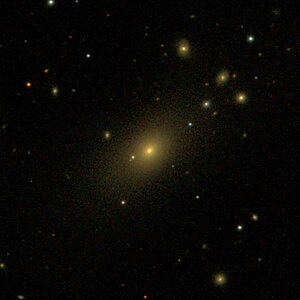NGC 4801
| Galaxie NGC 4801 | |
|---|---|
 | |
| SDSS-Aufnahme | |
| AladinLite | |
| Sternbild | Großer Bär |
| Position Äquinoktium: J2000.0, Epoche: J2000.0 | |
| Rektaszension | 12h 54m 37,7s[1] |
| Deklination | +53° 05′ 24″[1] |
| Erscheinungsbild | |
| Morphologischer Typ | E0[1] |
| Helligkeit (visuell) | 14,2 mag[2] |
| Helligkeit (B-Band) | 15,2 mag[2] |
| Winkelausdehnung | 0,9′ × 0,7′[2] |
| Positionswinkel | 138°[2] |
| Flächenhelligkeit | 13,6 mag/arcmin²[2] |
| Physikalische Daten | |
| Rotverschiebung | 0.054087 ± 0.000127[1] |
| Radialgeschwindigkeit | (16215 ± 38) km/s[1] |
| Hubbledistanz vrad / H0 | (729 ± 51) · 106 Lj (223,4 ± 15,6) Mpc [1] |
| Geschichte | |
| Entdeckung | Wilhelm Herschel |
| Entdeckungsdatum | 26. April 1789 |
| Katalogbezeichnungen | |
| NGC 4801 • PGC 43946 • CGCG 270-030 • MCG +09-21-060 • 2MASX J12543771+5305241 • GC 3306 • H III 816 • h 1479 • GALEXASC J125437.77+530524.5 | |
NGC 4801 ist eine 14,2 mag helle Linsenförmige Galaxie vom Hubble-Typ S0[2] im Sternbild Großer Bär am Nordsternhimmel. Sie ist schätzungsweise 729 Mio. Lichtjahre von der Milchstraße entfernt und hat einen Durchmesser von etwa 200.000 Lj.
Das Objekt wurde am 26. April 1789 von Wilhelm Herschel[3] mit einem 18,7–Zoll–Spiegelteleskop entdeckt, der sie dabei mit „eF, S, lE“[4] beschrieb.
Weblinks
- NGC 4801. SIMBAD, abgerufen am 14. Februar 2015 (englisch).
- NGC 4801. DSO Browser, abgerufen am 14. Februar 2015 (englisch).
- SIMBAD Astronomical Database
Einzelnachweise
Auf dieser Seite verwendete Medien
Autor/Urheber: Sloan Digital Sky Survey, Lizenz: CC BY 4.0
The sky image is obtained by Sloan Digital Sky Survey, DR14 with SciServer.
Angle of view: 4' × 4' (0.3" per pixel), north is up.
Details on the image processing pipeline: https://www.sdss.org/dr14/imaging/jpg-images-on-skyserver/



